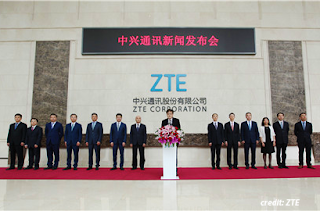Nokia introduced an Edge Cloud data center server for low-latency data processing demands of Cloud RANs, content caching and next-gen mobile application.
The Nokia AirFrame open edge cloud server is designed for deployment alongside base stations in 5G networks. It supports acceleration modules powered by the Nokia ReefShark chipset for 4G and 5G functions and applications, including Cloud RAN and content delivery, crypto and other applications. The server uses the latest Intel Xeon processors. Nokia said the design is inspired by Open Compute Project principles.
The AirFrame chassis supports up to five servers, each with a single Xeon processor.
 Nokia is also providing a real-time, Open Platform for NFV (OPNFV)-compatible, OpenStack-distribution built to run in small data centers while providing the performance and low latency required by the edge environment. Commercial shipments are expected in Q3.
Nokia is also providing a real-time, Open Platform for NFV (OPNFV)-compatible, OpenStack-distribution built to run in small data centers while providing the performance and low latency required by the edge environment. Commercial shipments are expected in Q3.
"The edge cloud will play an essential role in delivering the compute power required for 5G. By expanding our AirFrame and 5G Future X portfolio we can provide a network architecture that meets the needs of any operator and their customers. Used with the Nokia ReefShark chipset and our real-time cloud infrastructure software, the Nokia AirFrame open edge server will deliver the right decentralization of 4G and 5G networks. We can work with operators to ensure that data center capabilities are deployed exactly where they are needed to manage demands as they expand their service offering," stated Marc Rouanne, president of Mobile Networks at Nokia.
In January 2018, Nokia unveiled its ReefShark 5G chipsets for radio frequency (RF) units such as the radio used in antennas. The chipsets, which were developed in-house, significantly improve radio performance resulting in halving the size of massive MIMO antennas. Nokia says its ReefShark chipsets also reduce power consumption in baseband units by 64%, compared to current technology.
The ReefShark chipsets comprise:
The ReefShark chipsets for compute capacity are delivered as plug-in units for the commercially available Nokia AirScale baseband module. The new plug-in units triple throughput from 28 Gbps today to up to 84 Gbps per module. Additionally, AirScale baseband module chaining supports base station throughputs of up to 6 terabits per second. Nokia said this level of performance will allow operators to meet the huge growing densification demands and support the massive enhanced mobile broadband needs of people and devices in megacities.
Nokia also announced that it is working with 30 operators using ReefShark and will ramp up field deployments during the third quarter of 2018.
The Nokia AirFrame open edge cloud server is designed for deployment alongside base stations in 5G networks. It supports acceleration modules powered by the Nokia ReefShark chipset for 4G and 5G functions and applications, including Cloud RAN and content delivery, crypto and other applications. The server uses the latest Intel Xeon processors. Nokia said the design is inspired by Open Compute Project principles.
The AirFrame chassis supports up to five servers, each with a single Xeon processor.
 Nokia is also providing a real-time, Open Platform for NFV (OPNFV)-compatible, OpenStack-distribution built to run in small data centers while providing the performance and low latency required by the edge environment. Commercial shipments are expected in Q3.
Nokia is also providing a real-time, Open Platform for NFV (OPNFV)-compatible, OpenStack-distribution built to run in small data centers while providing the performance and low latency required by the edge environment. Commercial shipments are expected in Q3."The edge cloud will play an essential role in delivering the compute power required for 5G. By expanding our AirFrame and 5G Future X portfolio we can provide a network architecture that meets the needs of any operator and their customers. Used with the Nokia ReefShark chipset and our real-time cloud infrastructure software, the Nokia AirFrame open edge server will deliver the right decentralization of 4G and 5G networks. We can work with operators to ensure that data center capabilities are deployed exactly where they are needed to manage demands as they expand their service offering," stated Marc Rouanne, president of Mobile Networks at Nokia.
In January 2018, Nokia unveiled its ReefShark 5G chipsets for radio frequency (RF) units such as the radio used in antennas. The chipsets, which were developed in-house, significantly improve radio performance resulting in halving the size of massive MIMO antennas. Nokia says its ReefShark chipsets also reduce power consumption in baseband units by 64%, compared to current technology.
The ReefShark chipsets comprise:
- ReefShark Digital Front End for LTE and 5G radio systems supporting massive MIMO
- ReefShark RFIC front-end module and transceiver: massive MIMO Adaptive Antenna solution
- ReefShark Baseband Processor: All-in-one compute heavy design, capable of supporting the massive scale requirements of 5G. This is the brain power of baseband processing.
The ReefShark chipsets for compute capacity are delivered as plug-in units for the commercially available Nokia AirScale baseband module. The new plug-in units triple throughput from 28 Gbps today to up to 84 Gbps per module. Additionally, AirScale baseband module chaining supports base station throughputs of up to 6 terabits per second. Nokia said this level of performance will allow operators to meet the huge growing densification demands and support the massive enhanced mobile broadband needs of people and devices in megacities.
Nokia also announced that it is working with 30 operators using ReefShark and will ramp up field deployments during the third quarter of 2018.

















